DENNIS — When Samuel Tager was asked to curate a show at the Cape Cod Museum of Art, he had been thinking a lot about mural projects in Boston, Lynn, and Worcester. Murals typically have a life outside of museums, which was one of the reasons he was attracted to the artform.
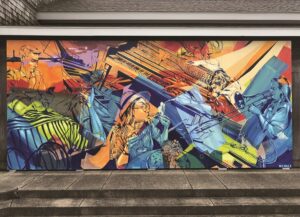
“Good mural artists really engage with the public,” says Tager. “They can beautify a place but not necessarily be part of gentrification. They give people in the community a sense of pride in their place.”
The challenge was to adapt this community-oriented, public-facing artform to the context of a museum, a traditionally more hermetic space. The resulting exhibition, featuring work by five artists, both embraces the conventions of gallery spaces and breaks beyond their confines.
After considering different ways he could celebrate muralists with a gallery exhibition, Tager landed on the idea of integrating indoor and outdoor components. And so, the show features three artists — Joe Wardwell, Jackie Reeves, and Esteban del Valle — who created commissioned murals flanking the museum’s entrance. Inside the museum, Felipe Ortiz and Sophy Tuttle created site-specific paintings on the walls.
The large rectangular exhibition space also features gallery paintings by the three artists whose work is outside. Although more suited to traditional exhibition spaces, these paintings reference the murals outside in both their scale and imagery and highlight the way in which mural artists often move seamlessly between a studio practice and public projects.
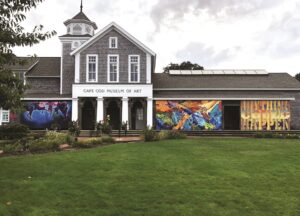
Viewed from a distance, the three outdoor murals bring an infusion of color to the museum’s traditional exterior, a prim Cape-style building with white trim and graying shingles. They’re doing what murals do best: reorienting a person’s experience of an outdoor space. Although Tager gave the artists little direction other than offering the same three-panel surface, the murals coalesce around Cape-centric imagery and thematic concerns that address instability and unease.
Both Wardwell, a Boston-based painter, and Reeves, who lives in Sandwich and works from a studio in Barnstable, address climate change in their work. Reeves painted a group of swimmers from an upward-looking perspective. The viewer doesn’t see the heads of the figures; the composition focuses attention on the depths of the sea floor where miniature houses rest, crumbling and broken. Moving upward, the composition transitions from dark blues to the warm, feverish colors of the swimmers and the hot colors of light hitting the water’s surface. The situation is knowingly ambiguous. Are the figures gasping for air or enjoying a day at the beach?
“My intention was to create some tension,” says Reeves.
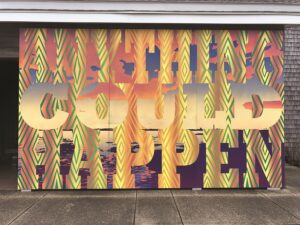
Wardwell’s mural conjures a similar mood, both ambiguous and ominous. Oversized text reading “anything could happen” is superimposed over an image of Provincetown Harbor at sunset.
“It could be read in many different ways,” says Wardwell. He lifted the phrase from a song by The Clean and initially thought it was reminiscent of a party atmosphere or a night out, but after experiencing floods in Vermont this summer, he began to associate the phrase more with environmental peril.
Wardwell’s painting practice, which encompasses both studio work and large-scale murals, is rooted in an engagement with bombastic rock lyrics and the Hudson River School, a politically resonant 19th-century art movement typified by grandiose scenes of the American landscape. Wardwell’s mural at the museum references the movement in its grand scale, sweeping views of the landscape, and twilight colors, but ultimately he provides an acerbic reassessment of American bravado. Here, the billboard-like messaging and sunset colors feel elegiac.
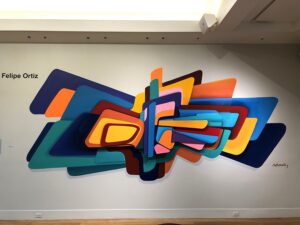
“It’s impossible to make a water image without thinking about encroaching erosion,” says Wardwell. Provincetown, depicted as a sliver of land sandwiched between sky and water, feels especially vulnerable in this painting — an image Wardwell describes as a “landscape of the new dawn.”
The Provincetown shoreline also shows up in del Valle’s mural, which he created to celebrate Provincetown’s buskers and in sober acknowledgement of the forces of gentrification threatening that community and the town’s creative identity at large. Del Valle, a two-time Fine Arts Work Center fellow, became acquainted with the town’s musicians while painting a mural, Time and the Town, on the side of the Marine Specialties building. It’s in an alleyway that is a popular spot for street musicians.
“Busking is another kind of public art,” says del Valle, who feels that these musicians embody Provincetown’s history as a place where artists came together to make art in an organic and “less cleaned up” way. “I find a camaraderie and kinship with these people,” says del Valle.

His mural at the museum features three street musicians: Will Harrington with his piano; Meagan Gillis playing trombone; and Sharky, on banjo, who came to the Cape from New Orleans at Harrington’s suggestion.
The musicians play in an off-kilter environment, communicated through del Valle’s use of an unstable diagonal composition and images of unimpressed tourists and a sinking ship. One man looks intently at his phone and a stylish young woman eats oysters while the ship breaks apart and the band plays on. (Here, del Valle was thinking about the orchestra playing on the deck as the Titanic sank.) The artist inserts himself in the scene, his back to the viewer and his arm raised with a martini in hand.
“I wanted to self-implicate,” says del Valle. “My hands aren’t clean from enjoying the luxuries of Provincetown.”
Despite setting himself apart from the musicians in the mural, del Valle hews closely to them in the form of the painting, which recalls the energy of jazz improvisation in the careening brush strokes and his virtuosic drawing, which fluctuates between short, staccato-like marks and more open, flowing gestures.
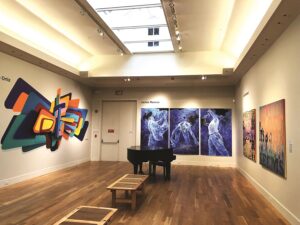
Inside the museum, the works on view further explore the ambitious scale of murals, but here the spatial conversation references interior rather than exterior space. Tuttle and Ortiz both created site-specific murals, which like other works in the exhibition, reference the natural world. Tuttle’s piece, which celebrates the 30th anniversary of the Mass. Endangered Species Act, consists of three overlapping concentric circles, each dedicated to an endangered animal, which she represents in three-dimensional relief sculptures.
Ortiz, who shows at Rugosa Gallery in Eastham, also blurs the lines between two-dimensional and three-dimensional space in his colorful mural. At the center of the wall hangs a wooden form that he painted in bright saturated colors. Extending outward and onto the wall are painted shapes echoing the sculpture and the shadows it projects. The resulting image, although the most abstract in the exhibition, recalls the form of a bird. The association isn’t surprising, considering Ortiz’s previous work based on bird migration patterns.
Taken as a whole, this exhibition challenges boundaries. Ortiz and Tuttle collapse boundaries between two-dimensional and three-dimensional space, and Wardwell, del Valle, and Reeves all move between interior and exterior environments and domains both private and public. Tager, who has curated two other exhibitions at the Cape Cod Museum of Art and serves as the executive director of the Provincetown Public Art Foundation, hopes this spirit of breaking boundaries extends to the audience.
“I thought working with mural artists would be an interesting way to bring in new audience members and new voices,” he says.
Walls That Connect
The event: The Cape Cod Mural Project group exhibition
The time: Through Nov. 12
The place: Cape Cod Museum of Art, 60 Hope Lane, Dennis
The cost: General admission: $10



